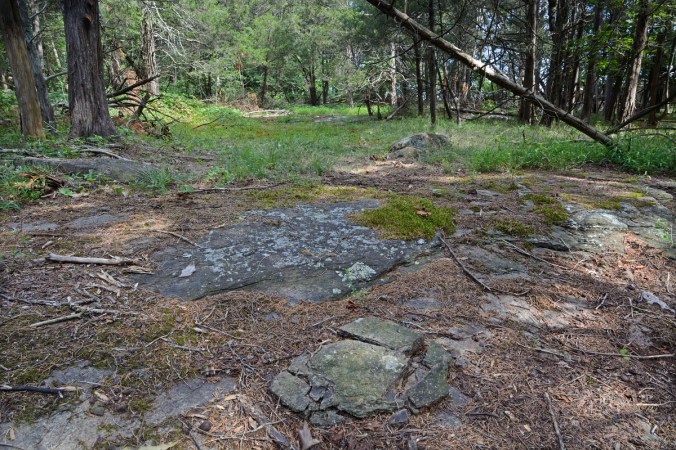I have been fascinated by plants and the natural world for as long as I can remember. Since I was a toddler, my mom would take my little brother and me to a nearby park almost every day to play in the woods, fields, and creeks. These days, a fellow plant-loving friend and I meticulously research and plan trips all around the state to look for new plants and plant communities. More than a year in advance, we planned a trip to the amphibolite outcrops of Naked Mountain Natural Area Preserve to see hundreds of blazing star plants in bloom. That trip was soon followed by an exciting late May trip to Difficult Creek Natural Area Preserve to see the diverse southern piedmont prairie and search for rare tall Barbara’s buttons (which we found!) Piney Grove Preserve, Chub Sandhill Natural Area Preserve, Shenandoah National Park, George Washington National Forest, and Grayson Highlands State Park are some of the other preserves and natural areas that I have visited this year looking for plants.
One reason I like plants so much is because they form the basic, tangible foundation for nature. Native plants create and define different ecological communities, which host all the other life forms, which have co-evolved with the plant species in the community. Witnessing the seemingly never-ending diversity of plants and the rich multi-species relationships of native plant communities is a source of great joy and mystery for me. There are few things I find more rewarding than researching and planning a trip to find a rare plant and then successfully discovering it growing where I thought it would. I also love the challenge of learning and identifying the huge number of plants native to our state.
I recently learned that Loudoun County’s Board of Supervisors is voting on January 18th on a proposal to raze a Piedmont Mafic Barren growing on a diabase formation on the banks of Goose Creek, in order to build a 750,000 square-foot data center. These barrens consist of two small separated outcroppings of diabase bedrock. Around the two barrens grows a stunted forest of eastern redcedar, white ash, eastern redbud, and fragrant sumac. The outcrops themselves are covered in dense patches of mosses and lichens, and sparse herbaceous plants such as Appalachian phacelia, awned flatsedge, and the state rare Central Appalachian endemic, Kate’s mountain clover.

Kates Mountain Clover (Trifolium virginicum) © Lonnie Murray
I was greatly disturbed by this news, as there are only 10 documented occurrences of Piedmont Mafic Barrens in the world, all of them in the Piedmont of Virginia. The Goose Creek site has the additional distinction of being the most northern example of this plant community, defining its range. The Piedmont Mafic Barren plant community is ranked by the Virginia Department of Conservation and Recreation as G1/S1, which means that it is critically imperiled globally.
Virginia is broadly divided into five physiographic provinces. From east to west, these are the Coastal Plain, Piedmont, Blue Ridge, Ridge and Valley, and Allegheny Plateau provinces. The landform, geology, and plant community types define the character of each of these regions in much the same way that historic buildings and architectural districts define the distinct character of cities and towns. Loudoun County, of course, is in the Piedmont province. Destroying the plant communities that make the Piedmont unique, such as the Piedmont Mafic Barren in Loudoun, degrades the essence and character of the Piedmont province.

The Loudoun County Piedmont Mafic Barren, © DCR-DNH, Gary P. Fleming.
I hope the Loudoun Board of Supervisors will deny the rezoning application and do all they can to protect the Piedmont Mafic Barren area. Whether I ever have the opportunity to visit it or not, its existence enriches my sense of place and offers an open invitation for exploration and discovery. While I’m interested in all plants, the ones that grow where I live are the most important to me. Knowing the plant communities of the piedmont makes me feel at home and helps give me a sense of belonging to the natural world. It heightens my appreciation of my surroundings every time I go outside.
I think if more people had the chance to experience the natural beauty of the Piedmont they would appreciate it more, and work harder to protect it. While we don’t know all the contributions any particular species or community makes to the ecosystem services we all depend on, we do know that each piece of the puzzle is valuable to the functioning of the whole. I hope that the Loudoun County Board of Supervisors won’t take away the opportunity to experience and learn from the Piedmont Mafic Barren from present and future generations.
Thanks for this post. Your knowledge and passion inspires me. All the best, Kirstin
LikeLike
Why do you want to Trump Loudon County? Please don’t exhibit your stable genius and distroy the rare natural beauty that you have been entrusted to protect.
LikeLike
Pingback: Kate's Mountain Clover: Trifolium virginicum - Virginia Native Plant Society
Sadly the Loudoun BOS last night voted that this area is better suited for a massive Data Center than being allowed to remain an ecological wonder, one more lost to the almighty dollar!
LikeLiked by 1 person
Enough already!
These new neverending housing & new’neigjbithoods’ are too much, & being created too rapidly, among some of the most beautiful, fertile, and abundant eco systems!
What is wrong with county planners saying enough is enough!?
LikeLike
Pingback: Exploring the Millboro Shale Formation: A Treasure Hunt for Endemic Plants | Birds and Buds